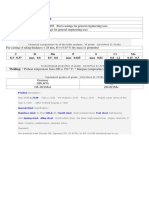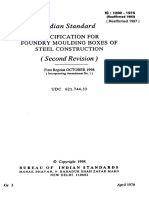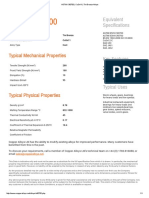BS2L99 Alloy Detail
BS2L99 Alloy Detail
Uploaded by
charles_boyle_3Copyright:
Available Formats
BS2L99 Alloy Detail
BS2L99 Alloy Detail
Uploaded by
charles_boyle_3Copyright
Available Formats
Share this document
Did you find this document useful?
Is this content inappropriate?
Copyright:
Available Formats
BS2L99 Alloy Detail
BS2L99 Alloy Detail
Uploaded by
charles_boyle_3Copyright:
Available Formats
BSL99 Aluminium Casting Alloy
BS2L99 ALUMINIUM CASTING ALLOY (A1-Si7Mg0.3)
This alloy conforms to British standard 2L99. Castings are standardized in the solution treated and precipitation treated condition. CHEMICAL COMPOSITION % Copper 0.10 max. Magnesium 0.20-0.45 (0.25-0.45) Silicon 6.5-7.5. Iron 0.20 max. (0.15) Manganese 0.10 max. Nickel 0.10 max. Zinc 0.10 max. Lead 0.05 max. Tin 0.05 max. Titanium 0.20 max. Aluminium Remainder Others: each (0.05) Others: total (0.15) Figures in brackets are ingot compositions where they differ from the casting, single figures are maxima.
MECHANICAL PROPERTIES SAND CAST 0.2%. Proof Stress (N/mm_) Tensile Stress (N/mm_) Elongation (%) Impact Resistance Izod (Nm) Brinell Hardness Endurance Limit (5x108 cycles; N/mm_) Modulus of Elasticity (x10_ N/mm_) Shear Strength (N/mm_) 185 230 2 75 56 71 160-180 CHILL CAST 200 280 5 80 90 71 170-200
The values in bold type are standardized properties for separately cast test samples produced to the requirements of BS 4L 101; those in normal type are typical properties. STRENGHT AT ELEVATED TEMPERATURES The tensile properties of 2L99 alloy at elevated temperatures are influenced by the condition (heat treatment) of the castings and the duration at the elevated temperature. For short term testing e.g., 30 minutes at temperature, the properties fall only slowly and uniformly up to about 200 C at which temperature the strength is reduced by approximately 20%. Very prolonged heating (10,000 hours) results in a sharp loss of strength at about 135 C, and at 200 C, the strength is less than half of that at room temperature.
BSL99 Aluminium Casting Alloy
PHYSICAL PROPERTIES Coefficient of Thermal Expansion (per C at 20-100C) Thermal Conductivity (cal/cm_/C at 25C) Electrical Conductivity (% copper standard at 20C) Density (g/cm_) Freezing Range (C)approx MACHINABILITY The heat-treated alloy has fairly good machining properties, but tools should preferably be of high speed steel, and must be kept sharp. A moderately high rate of tool wear may be expected. Liberal cutting lubricant should be employed. CORROSION RESISTANCE Resistance to corrosive attack by sea water and marine atmospheres is high. ANODIZING A protective anodic film can be obtained by either the sulphuric or chromic acid process but the grey opaque character of the coatings of normal thickness precludes their colouring in light shades for decorative purposes. CASTING CHARACTERISTICS FLUIDITY Good, suitable for fairly thin castings. PRESSURE TIGHTNESS Good, suitable for castings required to be leak tight. HOT-TEARING Excellent. Problems due to hot tearing are seldom encountered. TYPICAL POURING TEMPERATURE - 710 C The practical temperature may range between 675-790 C, depending on the mould configuration. PATTERNMAKERS SHRINKAGE 1.3% OR 1/75 HEAT TREATMENT BL 2L99 (fully heat treated) Heat for not less than 12 hours at 535-545C, quench in water at not less than 65C,or in a polymer quenchant not hotter than 30 C, followed by a precipitation treatment of not less than 4 hours at 150160C and air cool. APPLICATIONS 2L99 alloy is mainly used where good mechanical properties are required in castings of a shape or dimensions requiring and alloy of excellent castability in order to achieve the desired standard of soundness. The alloy is also used where resistance to corrosion is an important consideration, particularly where high strength is required. It is used for aircraft pump parts, aircraft fittings and control parts, aircraft structures and engine controls. 0.000022 0.36 39 2.68 615-550
You might also like
- Fan Static Pressure CalculationsDocument2 pagesFan Static Pressure Calculationsscribd9919088% (8)
- Aerospace Structural Metals HandbookDocument91 pagesAerospace Structural Metals Handbookcharles_boyle_3100% (1)
- Ignition ScriptingDocument152 pagesIgnition Scriptingvijikesh Arunagiri0% (1)
- JazmineDocument280 pagesJazmineRaven Nicole Morales100% (5)
- Alloy 276 Spec SheetDocument3 pagesAlloy 276 Spec SheetermusatNo ratings yet
- Automotive Gray Iron Castings: Standard Specification ForDocument5 pagesAutomotive Gray Iron Castings: Standard Specification Foralucard375No ratings yet
- Casting Material WCB PDFDocument9 pagesCasting Material WCB PDFChinmoyee SharmaNo ratings yet
- Low-Temperature Salt Bath Nitriding of SteelsDocument5 pagesLow-Temperature Salt Bath Nitriding of SteelsUriel PeñaNo ratings yet
- ASM Material Data SheetDocument2 pagesASM Material Data SheetShankar PranavNo ratings yet
- Assessment of Sand Casting Defects and Corrective Actions Carried Out: A ReviewDocument8 pagesAssessment of Sand Casting Defects and Corrective Actions Carried Out: A ReviewInternational Journal of Innovative Science and Research TechnologyNo ratings yet
- Aisi 305Document3 pagesAisi 305Aditya PratapNo ratings yet
- Astm E10 2001 PDFDocument9 pagesAstm E10 2001 PDFSofiaJabadanEspulgarNo ratings yet
- BrassDocument10 pagesBrassArjun CpNo ratings yet
- 277 - Galvanised Steel SheetsDocument10 pages277 - Galvanised Steel SheetsKaushik SenguptaNo ratings yet
- Iron & Steel Book in UrduDocument102 pagesIron & Steel Book in Urdumansoor_370596665No ratings yet
- Alloy No. Profile Grade Symbol Information Reference: Aluminum Strip in Plate, Sheet and Strip, Jis H4000Document1 pageAlloy No. Profile Grade Symbol Information Reference: Aluminum Strip in Plate, Sheet and Strip, Jis H4000Eko Prasetyo100% (1)
- Geomet 500 PDFDocument2 pagesGeomet 500 PDFKaran Chadha100% (1)
- Material Specification Sheet Saarstahl - 30Mnvs6 (27mnsivs6) - Saarform 900Document1 pageMaterial Specification Sheet Saarstahl - 30Mnvs6 (27mnsivs6) - Saarform 900RajaSekarsajja100% (1)
- Ferrous Metals: General Grade Cast IronsDocument8 pagesFerrous Metals: General Grade Cast IronskkamalakannaNo ratings yet
- MCM AllDocument7 pagesMCM AllPalanisamy RajaNo ratings yet
- LOW CARBON STEEL SHOT Vs HIGH CARBON STEEL SHOTDocument13 pagesLOW CARBON STEEL SHOT Vs HIGH CARBON STEEL SHOTPreeti Sharma EEELNo ratings yet
- Sintering Stainless SteelDocument42 pagesSintering Stainless SteelSteve GreenNo ratings yet
- Forging PDFDocument18 pagesForging PDFhrh_pogcNo ratings yet
- Surface Preparation Metallizing ProcedureDocument6 pagesSurface Preparation Metallizing ProcedureCorrosion FactoryNo ratings yet
- Etchant Test On CastingsDocument2 pagesEtchant Test On CastingsHarshaVeeragandhamNo ratings yet
- SDSS For ValvesDocument4 pagesSDSS For ValvesAhmed Ibrahim Ahmed EissaNo ratings yet
- Design For Assembly: Iit BombayDocument16 pagesDesign For Assembly: Iit Bombaytejap314No ratings yet
- Astm A 101Document3 pagesAstm A 101RECEP ÇETİNKAYANo ratings yet
- Extrusion Fig Q A AnalysisDocument13 pagesExtrusion Fig Q A AnalysisRavinder AntilNo ratings yet
- Ingot Crack: Presentation By: Sudipta DasDocument19 pagesIngot Crack: Presentation By: Sudipta Dassudipta dasNo ratings yet
- Rheocasting of Semi-Solid A357 AluminumDocument7 pagesRheocasting of Semi-Solid A357 AluminumikehrpNo ratings yet
- Technical Delivery Condition For: Hot Rolled Carbon (Micro Alloy) SteelDocument2 pagesTechnical Delivery Condition For: Hot Rolled Carbon (Micro Alloy) SteelManjunath UNo ratings yet
- G&S Valves, Retainer e LockDocument46 pagesG&S Valves, Retainer e LockFelipe SilvaNo ratings yet
- Indian Standard: Specification FOR Foundry Moulding Boxes of Steel Construction (Document13 pagesIndian Standard: Specification FOR Foundry Moulding Boxes of Steel Construction (Muthusamy Arumugam100% (1)
- Arcelomittal - SA - Hot-Dip Galvanised Cold Rolled and Hot Rolled Steel SubstrateDocument10 pagesArcelomittal - SA - Hot-Dip Galvanised Cold Rolled and Hot Rolled Steel SubstrateHen8No ratings yet
- Certified Reference Materials (CRM) : Csir-National Metallurgical Laboratory JAMSHEDPUR-831007, INDIADocument6 pagesCertified Reference Materials (CRM) : Csir-National Metallurgical Laboratory JAMSHEDPUR-831007, INDIAShiv PandeyNo ratings yet
- ASTM C90700 - CuSn11 - Tin Bronze AlloysDocument1 pageASTM C90700 - CuSn11 - Tin Bronze Alloysİrem Şebnem SorucuNo ratings yet
- Review: Friction Stir Welding Magnesium AZ31: Dipl. Ing. Jakob HilgertDocument23 pagesReview: Friction Stir Welding Magnesium AZ31: Dipl. Ing. Jakob HilgertTayron Zilli StapasollaNo ratings yet
- Metallography and Heat Treatment - Lab ReportDocument14 pagesMetallography and Heat Treatment - Lab ReportBrendan Jones0% (1)
- AMCOL - MCST - TR - HeviSand - Chromite - Double - Skin Defect - On - Heavy - Steel - Casting PDFDocument12 pagesAMCOL - MCST - TR - HeviSand - Chromite - Double - Skin Defect - On - Heavy - Steel - Casting PDFSUNDRAMNAGANo ratings yet
- Cast Iron (GG25, GGG40, GGG60)Document4 pagesCast Iron (GG25, GGG40, GGG60)Deden KurniawanNo ratings yet
- Latest Trends Investment Casting TechnologyDocument65 pagesLatest Trends Investment Casting TechnologySteve GreenNo ratings yet
- Astm B 480 - 88 R01Document3 pagesAstm B 480 - 88 R01SamuelNo ratings yet
- Adhesion Test - Applicable For Coatings Formed During Hot Dip GalvanizingDocument2 pagesAdhesion Test - Applicable For Coatings Formed During Hot Dip GalvanizingRaviprakash ChauhanNo ratings yet
- Casting Manufacturing Lab ReportDocument16 pagesCasting Manufacturing Lab ReportNiko KoNo ratings yet
- The Galv ProcessDocument6 pagesThe Galv Processheppy prastyo nugrohoNo ratings yet
- Chemical Composition: LM6 LM4Document2 pagesChemical Composition: LM6 LM4SiDdu KalashettiNo ratings yet
- HASTELLOY® C-22HS™alloyDocument16 pagesHASTELLOY® C-22HS™alloyYudha SatriaNo ratings yet
- Introduction To Electro-Slag Remelting (ESR)Document22 pagesIntroduction To Electro-Slag Remelting (ESR)Jahanzeb BhattiNo ratings yet
- U02P01 B.A.A Intro MetalCastingDocument35 pagesU02P01 B.A.A Intro MetalCastingmaria100% (1)
- Tool SteelsDocument35 pagesTool SteelsHandrizaHanifAsyrafiNo ratings yet
- 1.4462 Duplex PropertiesDocument2 pages1.4462 Duplex PropertiesEROL30No ratings yet
- Aluminized Steel Sheet PropertiesDocument8 pagesAluminized Steel Sheet PropertiesAhmadreza AminianNo ratings yet
- Sheet Metal WorkDocument29 pagesSheet Metal WorkSolcastic SoulNo ratings yet
- Atlas Aluminium Datasheet 5083Document3 pagesAtlas Aluminium Datasheet 5083Luis NunesNo ratings yet
- Non - Oriented - Bulletin AK Steel PDFDocument16 pagesNon - Oriented - Bulletin AK Steel PDFkoalaboiNo ratings yet
- 0803 - John Deere - Casting Repairing InstructionsDocument4 pages0803 - John Deere - Casting Repairing Instructionscrazy dNo ratings yet
- Welding Inspection: Heat Treatments Course Reference WIS 5Document24 pagesWelding Inspection: Heat Treatments Course Reference WIS 5Nguyen Xuan HaiNo ratings yet
- LM25 Aluminium Casting Alloy (Al - Si7Mg) : Chemical CompositionDocument3 pagesLM25 Aluminium Casting Alloy (Al - Si7Mg) : Chemical Compositiondaniel_sasikumar100% (1)
- Aluminum Alloy Specification'Document12 pagesAluminum Alloy Specification'ArjunNo ratings yet
- LM29Document6 pagesLM29Thangapandian NNo ratings yet
- Grade 2205 DuplexDocument9 pagesGrade 2205 Duplexkresimir.mikoc9765No ratings yet
- Die Casting AlloysDocument75 pagesDie Casting AlloysYuvaraj YuvarajNo ratings yet
- Seamless Stainless Steel Tube: Other Sizes Available On RequestDocument1 pageSeamless Stainless Steel Tube: Other Sizes Available On Requestcharles_boyle_3No ratings yet
- Steel Cross ReferenceDocument4 pagesSteel Cross Referencecharles_boyle_3No ratings yet
- Din 2448Document3 pagesDin 2448Cristian Adrian ANo ratings yet
- 1.0401 - C15Document1 page1.0401 - C15charles_boyle_3No ratings yet
- Needle en b173-217Document45 pagesNeedle en b173-217charles_boyle_3No ratings yet
- Unit Weight ScheduleDocument1 pageUnit Weight Schedulecharles_boyle_3No ratings yet
- MR 11plct Frevzfeb12Document496 pagesMR 11plct Frevzfeb12charles_boyle_3No ratings yet
- Keyway ChartDocument3 pagesKeyway Chartcharles_boyle_367% (3)
- MR 15plct Frevtfeb12Document476 pagesMR 15plct Frevtfeb12charles_boyle_30% (1)
- Kurvenrollen NTNDocument30 pagesKurvenrollen NTNcharles_boyle_3No ratings yet
- Cam FollowersDocument8 pagesCam Followerscharles_boyle_3100% (1)
- Gravity Die Castings Tolerance Guide Functional Dimensions Millimetres Dimension ToleranceDocument1 pageGravity Die Castings Tolerance Guide Functional Dimensions Millimetres Dimension Tolerancecharles_boyle_3No ratings yet
- E 1421Document11 pagesE 1421charles_boyle_3No ratings yet
- LM4 Alloy DetailDocument5 pagesLM4 Alloy Detailcharles_boyle_3No ratings yet
- LM9 Alloy DetailDocument3 pagesLM9 Alloy Detailcharles_boyle_3No ratings yet
- Icces 2008 007 023Document20 pagesIcces 2008 007 023charles_boyle_3No ratings yet
- A356.0 Alloy DetailDocument2 pagesA356.0 Alloy Detailcharles_boyle_3No ratings yet
- Investigation of Dynamic Displacements of Lithographic Press Rubber Roller by Time Average Geometric MoireDocument12 pagesInvestigation of Dynamic Displacements of Lithographic Press Rubber Roller by Time Average Geometric Moirecharles_boyle_3No ratings yet
- Advancements in Electric MachinesDocument56 pagesAdvancements in Electric Machinescharles_boyle_3No ratings yet
- On Basic Electrical - 1Document18 pagesOn Basic Electrical - 1Sakshi RanaNo ratings yet
- Have Mercy On Us AutosavedDocument11 pagesHave Mercy On Us AutosavedMyrel Cedron TucioNo ratings yet
- Unit 2 Assessment - Attempt Review - Saylor AcademyDocument24 pagesUnit 2 Assessment - Attempt Review - Saylor AcademyDAVID SEDZRONo ratings yet
- Chief Mate - Phase 1 - Cargo Handling and Stowage-18052011Document11 pagesChief Mate - Phase 1 - Cargo Handling and Stowage-18052011madhan01kumar0% (2)
- Automobile Industry: Risk ManagementDocument18 pagesAutomobile Industry: Risk ManagementYasmin HussainNo ratings yet
- Copia de Formato1Document2 pagesCopia de Formato1Isabel LimónNo ratings yet
- ITEC-425 / SENG-425: Python Programming Lab Lab 6: Working With Files I/ODocument3 pagesITEC-425 / SENG-425: Python Programming Lab Lab 6: Working With Files I/OUmm E Farwa KhanNo ratings yet
- 2010 - Investigation of Wind Energy Potential of Muradiye in Manisa, TurkeyDocument5 pages2010 - Investigation of Wind Energy Potential of Muradiye in Manisa, TurkeygxydisNo ratings yet
- EuphoriaDocument2 pagesEuphoriaAmit MalhotraNo ratings yet
- Technical and Operating Instructions Manual Along With Cpl/PilDocument13 pagesTechnical and Operating Instructions Manual Along With Cpl/PilCidhin NairNo ratings yet
- Sustainable Use of Resources - Grade 9Document9 pagesSustainable Use of Resources - Grade 9Tina MoyeniNo ratings yet
- The Effect of Electrical Lighting Power and Irradiance On Indoor-Grown Cannabis Potency and Yield PDFDocument5 pagesThe Effect of Electrical Lighting Power and Irradiance On Indoor-Grown Cannabis Potency and Yield PDFTony AnandaNo ratings yet
- Menumbuhkan Minat Baca Masyarakat Melalui Taman Bacaan Masyarakat Berbasis Teknologi InformasiDocument12 pagesMenumbuhkan Minat Baca Masyarakat Melalui Taman Bacaan Masyarakat Berbasis Teknologi InformasiDani TrashNo ratings yet
- ch11 Human Endocrine System Vanders Human Physiology 15e Chap011Document38 pagesch11 Human Endocrine System Vanders Human Physiology 15e Chap011sueda123eybNo ratings yet
- Pretest Posttest AssignmentDocument12 pagesPretest Posttest AssignmentAbdirahmanNo ratings yet
- Critical Dimensions of V-Shape PackingsDocument2 pagesCritical Dimensions of V-Shape PackingsKalpana BansalNo ratings yet
- Case Analysis On Jayanta Kumar Das Vs State of OdishaDocument13 pagesCase Analysis On Jayanta Kumar Das Vs State of OdishaAditya DwivediNo ratings yet
- FMDS0281Document67 pagesFMDS0281Sandeep YadavNo ratings yet
- 8.4 Polar Bonds NewDocument25 pages8.4 Polar Bonds Newswailemnouf7No ratings yet
- Notion SQL CodeDocument4 pagesNotion SQL CodephurinthammarowetNo ratings yet
- LaajVanti EbookDocument179 pagesLaajVanti EbookSridhar YvNo ratings yet
- Research Methods in ManagementDocument71 pagesResearch Methods in ManagementArohi ChaturvediNo ratings yet
- Cse I SemDocument2 pagesCse I SemwarlordNo ratings yet
- Trends and Practices in Financial Planning in Pune:The Curious Case of Yadnya Investment ServiceDocument51 pagesTrends and Practices in Financial Planning in Pune:The Curious Case of Yadnya Investment ServiceAli SaifyNo ratings yet
- CFD Modelling Approaches Against Single Wind Turbine Wake Measurements Using RANSDocument17 pagesCFD Modelling Approaches Against Single Wind Turbine Wake Measurements Using RANSTareq Abdussalam KhamllagNo ratings yet
- PDFDocument15 pagesPDFHina Sahar100% (1)
- D.C.-D.C. Conversion (1) : Buck Converter 6.1 Operation: in This LectureDocument4 pagesD.C.-D.C. Conversion (1) : Buck Converter 6.1 Operation: in This LectureHassan FarssiNo ratings yet













































































































